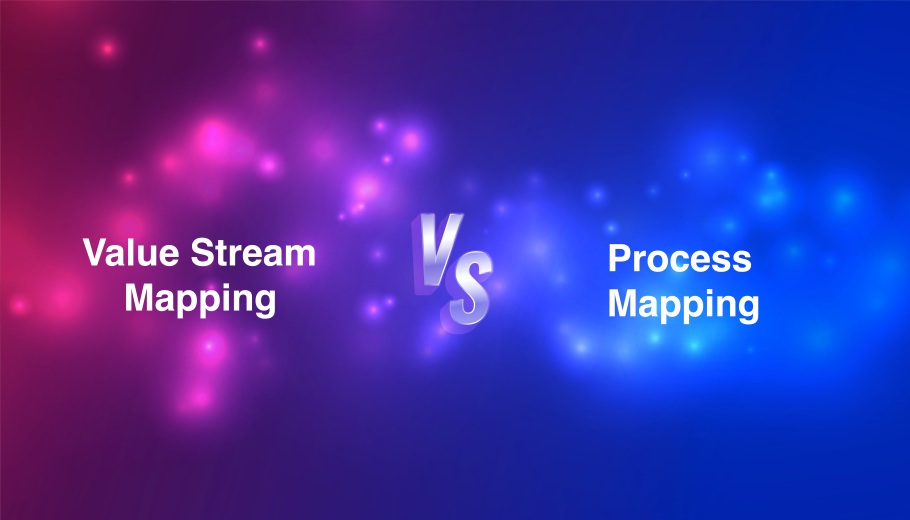There is no doubt that in the race to develop an ideal business landscape, a sharp-shooting focus on unlocking operational efficiency is the need of the hour. Two popular methodologies that have gained significant traction in this pursuit are Value Stream Mapping (VSM) and Process Mapping.
These mapping tools provide businesses with valuable insights into their operations, enabling them to identify bottlenecks, streamline processes, and enhance overall productivity.
But how do these two approaches differ, and which one is best suited for your organization? In this article, we will delve into the world of operational efficiency and explore the nuances of Value Stream Mapping Vs Process Mapping. By understanding the unique strengths of each methodology, you will be equipped with the knowledge to make informed decisions and drive transformative changes within your organization.
Understanding Value Stream Mapping
Value Stream Mapping (VSM) is a lean management technique that focuses on visualizing the flow of materials, information, and the entire process required to deliver a product or fulfill a customer order. Value streams provide a holistic view of the entire value stream, from raw materials to the end product, including all the steps and interactions involved.
By generating a value stream map, organizations can identify areas of waste, such as unnecessary steps, delays, or redundancies, and devise strategies to eliminate or minimize them. Value Stream Management helps in understanding the value-added activities and non-value-added activities within a process, allowing for targeted improvements.
Benefits of Value Stream Mapping
The process of creating Value Stream Maps offers several key benefits to organizations:
1. Identifying Bottlenecks and Waste
A value stream map allows businesses to identify bottlenecks and areas of waste within their processes. By visualizing the flow and analyzing the value stream, organizations can pinpoint areas where resources are being underutilized or where delays and inefficiencies occur.
2. Streamlining Business Processes
Once bottlenecks and waste have been identified, organizations can start with process improvement. This may involve eliminating unnecessary steps, improving communication and coordination between departments, or implementing automation and technology solutions.
3. Enhancing Productivity and Efficiency
By streamlining the existing processes and eliminating waste, organizations can significantly enhance their productivity and efficiency. This leads to swift turnaround times, managed costs, and enhanced customer satisfaction.
4. Increasing Collaboration and Communication
Value Stream Mapping encourages cross-functional collaboration and communication. By involving employees from different departments in the mapping exercise, organizations can break down silos and foster a culture of collaboration, leading to better problem-solving and decision-making.
Are you looking to streamline your operations with value stream mapping or process mapping?
Contact Growth Hackers
How to Carry Out a Value Stream Mapping Exercise
Here are the key steps involved in the Value Stream Mapping process:
- Select the value stream: Identify the specific value stream that you want to map. This could be a particular product line, service offering, or a specific process within your organization.
- Create a current state map: Begin by mapping out the current state of the value stream. This involves documenting all the steps, activities, and interactions involved in delivering the product or service. Use symbols and visual aids to represent each step and indicate the flow of materials, information, and processes.
- Analyze the current state map: Once the current state map is complete, analyze the existing operations to identify areas of waste, bottlenecks, and inefficiencies. Look for opportunities to eliminate or minimize non-value-added activities and streamline the flow.
- Design a future state map: Based on the analysis of the current state map, design a future state map that represents the ideal flow of the value stream. This map should address the identified bottlenecks and waste, and incorporate improvements to enhance efficiency and productivity.
- Develop an implementation plan: Once the future state map is complete, develop an implementation plan to execute the necessary changes and improvements. This may involve reorganizing workflows, training employees, or implementing new technologies.
Analyzing and Improving the Value Stream
Analyzing and improving the value stream requires a systematic approach:
1. Identify waste: Analyze the current state map to identify areas of waste, such as waiting times, unnecessary movement, overproduction, or defects. The management principles according to TIMWOOD categorize these wastes into Transportation, Inventory, Motion, Waiting, Overproduction, Over-processing, and Defects.
2. Map the information flow: In addition to the physical flow of materials, value stream mapping also includes the flow of information. Map out how information is shared and communicated within the value stream, and identify any bottlenecks or delays in the information flow.
3. Set improvement goals: Based on the identified wastes and bottlenecks, set specific improvement goals for the value stream. These goals should be measurable and aligned with the overall objectives of the organization.
4. Implement improvements: Develop and implement improvement strategies to address the identified wastes and achieve the set goals. This may involve reengineering processes, implementing new technologies, or introducing lean management practices.
5. Monitor and measure: Continuously monitor and measure the performance of the value stream to ensure that the improvements are effective and sustainable. Use key performance indicators (KPIs) to track progress and identify areas that require further attention.
Benefits of Process Mapping
While Value Stream Mapping provides a holistic view of the entire value stream, Process Mapping Value focuses on a specific process or workflow within an organization. It provides a better understanding and a detailed visual representation of the steps, activities, and interactions involved in a particular process, enabling organizations to analyze and improve their efficiency.
Here are some key benefits of Process Mapping:
Understanding Process Flow
Process Mapping helps organizations gain a clear understanding of how a specific process flows, from start to finish. It allows for a detailed examination of the sequence of steps, handoffs, and decision points within the process.
Identifying Bottlenecks and Inefficiencies
By mapping out the process, organizations can identify bottlenecks, delays, and inefficiencies that may be hindering its smooth execution. This enables targeted improvements to enhance efficiency and productivity.
Visualizing Dependencies and Interdependencies
Process Mapping provides a visual representation of the dependencies and interdependencies between different steps and activities within a process. This helps in identifying areas where changes in one part of the process may impact other areas.
Enhancing Communication and Training
Process maps serve as valuable communication and training tools. They provide a visual reference that can be easily understood by employees, facilitating better communication and comprehension of the process requirements.
How to Create a Process Map
Creating a Process Map involves the following steps:
- Identify the process: Select the specific process that you want to map. This could be a core business process, that includes some key process data, such as order fulfillment or customer onboarding, or a supporting process, such as inventory management or quality control.
- Define the boundaries: Clearly define the boundaries of the process to be mapped. Determine the start and end points of the process and identify any inputs, outputs, or dependencies on other processes.
- Identify the steps: Break down the process into individual steps or activities. Document each step and its associated inputs, outputs, and decision points. Use symbols and visual aids to represent each step and indicate the flow of activities.
- Map the sequence: Arrange the steps in the order they occur within the process. Connect the steps with arrows to indicate the flow and sequence of activities.
- Include decision points: If the process includes decision points or branches, indicate them in the process map. Use decision diamonds or other symbols to represent these points and clearly indicate the different paths or options.
- Include inputs and outputs: Document the inputs and outputs associated with each step in the process. This helps in understanding the information or materials required at each stage and the results or outcomes produced.
- Review and refine: Once the process map is complete, review it for accuracy and completeness. Make any necessary refinements or adjustments to ensure that the map accurately represents the process flow.
Analyzing and Improving the Process Map
Analyzing and improving the process map requires a systematic approach:
1. Identify bottlenecks: Analyze the process map to identify bottlenecks or areas of inefficiency. Look for steps that take longer than necessary, involve unnecessary handoffs, or require excessive resources.
2. Eliminate non-value-added activities: Identify and eliminate non-value-added activities within the process. These are steps or activities that do not contribute directly to the creation of value for the customer. Streamline the process by removing or minimizing these activities.
3. Simplify and standardize: Look for opportunities to simplify and standardize the process. Simplify complex steps, reduce the number of handoffs, and standardize work procedures to enhance efficiency and reduce the likelihood of errors or variability.
Maximize efficiency with value stream mapping and process mapping today!
4. Automate and digitize: Where possible, consider automating or digitizing certain steps or activities within the process. This can help in reducing manual effort, improve accuracy, and speed up the overall process flow.
5. Measure and monitor: Establish key performance indicators (KPIs) to measure the performance of the process. Continuously monitor the KPIs to identify areas that require improvement and track the impact of implemented changes.
Comparing Value Stream Mapping and Process Mapping
While both Value Stream Mapping and Process Mapping are valuable tools for improving operational efficiency, they differ in their scope and focus.
Value Stream Mapping provides a high-level view of the entire value stream, from raw materials to the end product, and helps in identifying waste and bottlenecks. It is particularly useful for organizations that want to optimize their overall value chain and eliminate inefficiencies across multiple processes.
On the other hand, Process Mapping focuses on a specific process or workflow within an organization. It provides a detailed view of the steps, activities, and interactions involved in that process, facilitating targeted improvements to enhance efficiency and productivity.
When deciding between Value Stream Mapping and Process Mapping, consider the following factors:
- Scope and complexity: Value Stream Mapping is best suited for organizations that want to analyze and optimize their entire value stream, encompassing multiple processes and departments. Process Mapping, on the other hand, is more suitable for organizations that want to focus on a specific process or workflow.
- Level of detail: Value Stream Mapping provides a high-level view of the value stream, while Process Mapping offers a more detailed representation of a specific process. Consider the level of detail required to address the specific challenges or opportunities within your organization.
- Cross-functional collaboration: Value Stream Mapping encourages cross-functional collaboration and communication. If you are looking to break down silos and foster collaboration between different departments, Value Stream Mapping may be the preferred approach.
- Targeted improvements: If you have identified a specific process that requires improvement or optimization, Process Mapping allows for targeted improvements by providing a detailed understanding of the process flow and bottlenecks.
- Overall strategic goals: Consider your organization’s overall strategic goals and objectives. Determine whether a holistic view of the value stream or a more focused approach to a specific process aligns better with your long-term objectives.
Final Thoughts on Value Stream Mapping Vs Process Mapping
In the quest for operational efficiency, organizations can leverage both Value Stream Mapping and Process Mapping to drive transformative changes. While Value Stream Mapping provides a holistic view of the entire value stream, Process Mapping offers a more detailed analysis of specific processes.
By unlocking operational efficiency through Value Stream Mapping or Process Mapping, you can pave the way for continuous improvement, reduced costs, and increased customer satisfaction. Choose the approach that aligns best with your organization’s needs and embark on a journey toward operational excellence.
Consider giving your operations an added ROI boost by upgrading your digital marketing efforts. With GrowthHackers, you don’t have to sweat the small stuff; instead, you can focus on building your business to its potential.
At Growth Hackers, we believe in taking a comprehensive approach toward growing your business sustainably while boosting ROI. Our team of experts is constantly monitoring and analyzing market trends, consumer behavior, preferences, and industry insights to tailor our solutions to meet your business goals. We leverage the latest technologies and tools to provide data-driven insights and recommendations that will help you gain a competitive advantage, increase brand awareness, and drive more qualified leads to your sales pipeline.
With our proven track record and expertise, you can trust Growth Hackers to take your business to the next level. Contact Growth Hackers today to get growing together.








